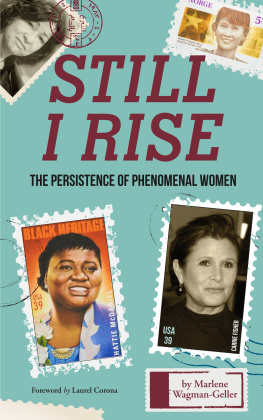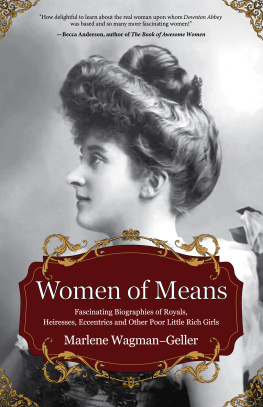Women
Who
Launch
Also by Marlene Wagman-Geller
Still I Rise: The Persistence of Phenomenal Women
Behind Every Great Man: The Forgotten Women Behind the Worlds Famous and Infamous
And the Rest is History: The Famous (and Infamous) First Meetings of the Worlds Most Passionate Couples
Eureka! The Surprising Stories Behind the Ideas That Shaped
the World
Once Again to Zelda: The Stories Behind Literatures Most Intriguing Dedications
Women
Who
Launch
Women Who Shattered
Glass Ceilings
Marlene Wagman-Geller

Copyright 2018 Marlene Wagman-Geller
Published by Mango Publishing Group, a division of Mango Media Inc.
Cover, Layout & Design: Morgane Leoni
Mango is an active supporter of authors rights to free speech and artistic expression in their books. The purpose of copyright is to encourage authors to produce exceptional works that enrich our culture and our open society.
Uploading or distributing photos, scans or any content from this book without prior permission is theft of the authors intellectual property. Please honor the authors work as you would your own. Thank you in advance for respecting our authors rights.
For permission requests, please contact the publisher at:
Mango Publishing Group
2850 Douglas Road, 3rd Floor
Coral Gables, FL 33134 U.S.A.
For special orders, quantity sales, course adoptions and corporate sales, please email the publisher at or +1.800.509.4887.
Women Who Launch: Women Who Shattered Glass Ceilings
Library of Congress Cataloging
ISBN: (p) 978-1-63353-695-1, (e) 978-1-63353-696-8
Library of Congress Control Number: 2017962523
BISAC - SOC028000 SOCIAL SCIENCE / Womens Studies
- BUS046000 BUSINESS & ECONOMICS / Motivational
Printed in the United States of America
To the memory of my mother Gilda Wagman.
With love for my daughter Jordanna Shyloh Geller.
Somewhere over the rainbow
Skies are blue
And the dreams that you dare to dream
Really do come true.
Judy Garland as Dorothy (1939)
Contents

If a sociologist held a mirror to the 1950s, it would have reflected a flat line in the march to level the gender playing field. The term ladies who lunched described the eras wealthy wivesMrs. So-and-Sos who used both their husbands given and surnameshandmaidens to the mundane. Their outlet was to frequent the best restaurants to see and to be seen. These establishments served small portions for high prices; skimpy servings were no problem, though, as the weight-conscious females did very little eating. The sauce for their meals was gossip.
The ladies who lunched in Manhattan were an especially well-heeled subset of the breed. The Colony in New York was the first restaurant in the 1930s to import Dom Prignon, and the only one where the ladies could check their Yorkies and pugs along with their minks and chinchillas. A Van Cleef & Arpels was an adjacent concession. One of the members of this elite group, the Duchess of Windsor, was sadly serious when she famouslyand fatuouslydelivered her maxim, A woman cant be too rich or too thin. She also made the lesser-known but equally expected pronouncement, All my friends know Id rather shop than eat. Yes, these well-heeled matrons seemed so glamorous in their dresses with the nipped-in waists and their elegant black pumps. The crack in the pretty picture was that the 50s was the era of the captive wife. Fanny Brice in Funny Girl sang a tongue-in-cheek reference to the arid desert of matrimony: Im Sadie, Sadie, married lady,/Still in bed at noon,/Racking my brain deciding/Between orange juice and prune...
In sharp juxtaposition, there were intrepid women who launched rather than lunchedinstead of waiting for a glass slipper, they shattered glass ceilings. One of these, Josephine Esther Mentzer, began life in an apartment over her Hungarian fathers hardware store in Queens. Armed with her uncles cold creams and her own innate chutzpah, she reinvented herself into the cosmetics queen Este Lauder. Among her roster of friends and clients were Princesses Grace and Diana, First Lady Nancy Reagan, and the Duchess of Windsor. When she passed the torch to her sonsthe Kennedys of the beauty worldshe left them a legacy of billions. Her son Ronald Lauders $135 million purchase of Klimts world-famous painting Woman in Gold , a luxurious fin de sicle icon from her fathers native Hungary, would have met with her smile of approval. Similarly, Este would have nodded her headalways perfectly coiffedat her daughter-in-law Evelyns pink ribbon campaign, which became the ubiquitous symbol of the battle against breast cancer.
The founding of museums usually connotes male prerogative: the Guggenheim, after Solomon R.; the Smithsonian, after James Smithson; the Tate, after Sir Henry. Womens lot was to have their likenesses hang on their walls, encased in gilded, often evocative poses. What added estrogen to this mix was waxworker wunderkind Marie Grosholzthe architect of Madame Tussauds, a hall of wonders that has remained for two centuries and is one of Londons crown jewels.
When one thinks of the newspapers of yesteryear, the image that comes to mind is men with ink-stained fingers bending over their printing presses. And the media tycoons behind the scenes cast the giant shadows of Joseph Pulitzer and William Randolph Hearst. In the contemporary era, the formerly testosterone-fueled media has been impacted by Greek-born Arianna Huffington. On a shoestring budget, she launched the eponymous Huffington Post , which was subsequently sold to AOL for $315 million. As a well-connected wielder of political cloutshe has the world leaders on her smartphones speed dialif angered, she can huff and puff....
The nemesis of women scaling to new heights can be attributed to the Lex Luthor of female empowerment: gender stereotyping. For our mothers, sexism was explicit. Their stories would make any Title IX compliance officer of today perform a full-body heave. My father told me that it was OK for girls not to do well in math, and that the only respectable profession was to be a housewife. However, he did make the concession that if I had to work, I could become a teacherwhich I did. When my mother stated she wanted a job, her remark was met with hostility; he said that when a wife worked, it denigrated her husbands ability as a provider. It would never have occurred to him to shop, cook, or change a diaper. In his defense, my old-country father was in good stead with the societal mores of the time. Letters for my mother were addressed to Mrs. Harry Wagman. It was a milieu where credit cards were only issued in a husbands name, a female physician was so rare that she would inevitably be referred to as the woman doctor, and juries excluded the possessors of estrogen.
A conundrum faced by women is if they stay boxed in by the dictates of the paradigmpassive, sweet, agreeablethey may not be viewed as mover-and-shaker material. But if they try to break free from this molddecisive, aggressive, and assertiveare often perceived as bossy. During the 2016 election, men held up iron my shirt signs, showing that sexism still has not been put to rest. To combat this mindset, Sheryl Sandberg, with her Lean In Foundation, has done her utmost to help combat collective chauvinism.
William Wordsworth, in his poem My Heart Leaps Up, wrote, The Child is father of the Manour youth is a preface to the future. Deeply ingrained bias can be traced to the paradigm that boys are brought up believing they need to get jobs and make money; their fire engines and toy cars put them in the drivers seat. Girls are raised to marry good providers, their dolls and dollhouses conditioning them for their roles as mothers. It is time for the blending of the blue and the pink. Until the traditional mindset is altered, men will continue to hunt trophy wives and women will continue in their perspective that husbands are ATM dispensers.
Next page













